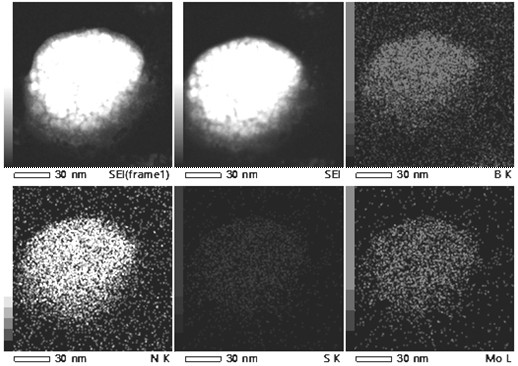A h-bn/mos for targeted photothermal and chemical synergistic therapy 2 Nanoprobe and its preparation method and application
A nanoprobe, h-bn technology, applied in the field of nanoprobes, can solve the problems of limited sensitivity, single treatment method, no fluorescence and Raman dual-mode detection and analysis, etc. The effect of high infrared absorption and superior optical properties
- Summary
- Abstract
- Description
- Claims
- Application Information
AI Technical Summary
Problems solved by technology
Method used
Image
Examples
Embodiment 1
[0058] h-BN / MoS 2 The nanoprobe is prepared according to the following preparation method:
[0059] (1) Synthesis of h-BN nanosheets
[0060] Dissolve 1g of hexagonal boron nitride powder in 50mL of concentrated sulfuric acid, and use magnetic stirring to slowly add 0.5g of KMnO 4 , the solution changed from white to green, and continued stirring for 12h. Then, 10 mL of 30% H was added to the mixed solution 2 O 2 . After the solution was cooled to room temperature, the suspension was obtained by ultrasonic treatment for 1 h. The suspension was centrifuged for 10 min, and the centrifuged white solid powder at 8000-12000 rpm was retained to remove the h-BN nanosheets with too large or too small particle size. The centrifuged white solid powder was washed repeatedly with deionized water until the pH of the solution was neutral. Finally, the solid powder was vacuum-dried at 60 °C for 12 h to obtain h-BN nanosheets.
[0061] (2) MoS 2 Synthesis and modification of quantum d...
Embodiment 2
[0094] Example 2 DOX@h-BN / MoS 2 Construction and application of nanoformulations
[0095] ①DOX loading and releasing
[0096] The h-BN / MoS 2 Nanoprobes (0.2mL, 1.0mg / mL) and DOX solution (0.2mL, 1.0mg / mL) were diluted to 1mL with PBS buffer, shaken at room temperature for 24h, and centrifuged to separate DOX@h-BN / MoS 2 Nanoformulations and unloaded DOX solutions. The supernatant solution was collected, using a Hitachi F-4600 fluorescence spectrophotometer (E X = 488 nm) to measure the fluorescence of the supernatant. And compared h-BN / MoS by hydrodynamic particle size and Zeta potential experiments 2 Changes before and after loading the nanoprobe with DOX and PBS buffers with different pH (pH=5.5, 6.5 and 7.4), and the DOX fluorescence after shaking at room temperature for 12 h.
[0097] Further investigation of DOX@h-BN / MoS by fluorescence in the supernatant under different pH buffer media 2 Release capacity of nanoformulations. The DOX@h-BN / MoS 2 Nanoformulations (2...
PUM
 Login to View More
Login to View More Abstract
Description
Claims
Application Information
 Login to View More
Login to View More - R&D
- Intellectual Property
- Life Sciences
- Materials
- Tech Scout
- Unparalleled Data Quality
- Higher Quality Content
- 60% Fewer Hallucinations
Browse by: Latest US Patents, China's latest patents, Technical Efficacy Thesaurus, Application Domain, Technology Topic, Popular Technical Reports.
© 2025 PatSnap. All rights reserved.Legal|Privacy policy|Modern Slavery Act Transparency Statement|Sitemap|About US| Contact US: help@patsnap.com



